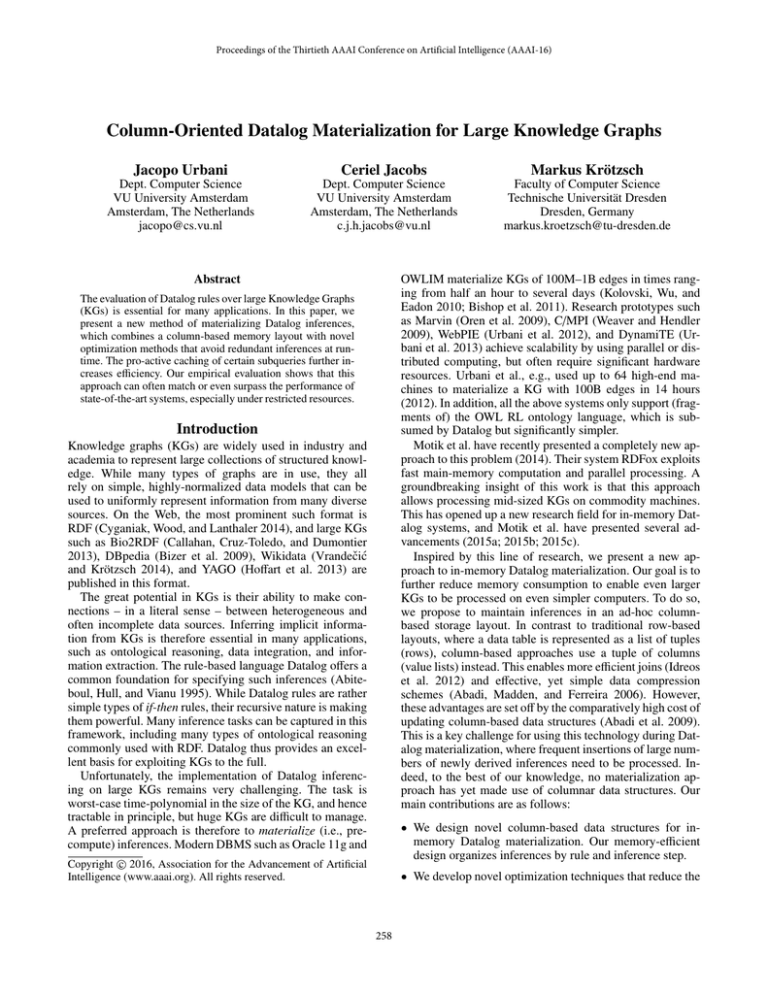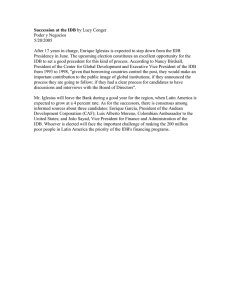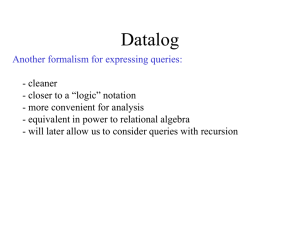
Proceedings of the Thirtieth AAAI Conference on Artificial Intelligence (AAAI-16)
Column-Oriented Datalog Materialization for Large Knowledge Graphs
Jacopo Urbani
Ceriel Jacobs
Markus Krötzsch
Dept. Computer Science
VU University Amsterdam
Amsterdam, The Netherlands
jacopo@cs.vu.nl
Dept. Computer Science
VU University Amsterdam
Amsterdam, The Netherlands
c.j.h.jacobs@vu.nl
Faculty of Computer Science
Technische Universität Dresden
Dresden, Germany
markus.kroetzsch@tu-dresden.de
OWLIM materialize KGs of 100M–1B edges in times ranging from half an hour to several days (Kolovski, Wu, and
Eadon 2010; Bishop et al. 2011). Research prototypes such
as Marvin (Oren et al. 2009), C/MPI (Weaver and Hendler
2009), WebPIE (Urbani et al. 2012), and DynamiTE (Urbani et al. 2013) achieve scalability by using parallel or distributed computing, but often require significant hardware
resources. Urbani et al., e.g., used up to 64 high-end machines to materialize a KG with 100B edges in 14 hours
(2012). In addition, all the above systems only support (fragments of) the OWL RL ontology language, which is subsumed by Datalog but significantly simpler.
Motik et al. have recently presented a completely new approach to this problem (2014). Their system RDFox exploits
fast main-memory computation and parallel processing. A
groundbreaking insight of this work is that this approach
allows processing mid-sized KGs on commodity machines.
This has opened up a new research field for in-memory Datalog systems, and Motik et al. have presented several advancements (2015a; 2015b; 2015c).
Inspired by this line of research, we present a new approach to in-memory Datalog materialization. Our goal is to
further reduce memory consumption to enable even larger
KGs to be processed on even simpler computers. To do so,
we propose to maintain inferences in an ad-hoc columnbased storage layout. In contrast to traditional row-based
layouts, where a data table is represented as a list of tuples
(rows), column-based approaches use a tuple of columns
(value lists) instead. This enables more efficient joins (Idreos
et al. 2012) and effective, yet simple data compression
schemes (Abadi, Madden, and Ferreira 2006). However,
these advantages are set off by the comparatively high cost of
updating column-based data structures (Abadi et al. 2009).
This is a key challenge for using this technology during Datalog materialization, where frequent insertions of large numbers of newly derived inferences need to be processed. Indeed, to the best of our knowledge, no materialization approach has yet made use of columnar data structures. Our
main contributions are as follows:
Abstract
The evaluation of Datalog rules over large Knowledge Graphs
(KGs) is essential for many applications. In this paper, we
present a new method of materializing Datalog inferences,
which combines a column-based memory layout with novel
optimization methods that avoid redundant inferences at runtime. The pro-active caching of certain subqueries further increases efficiency. Our empirical evaluation shows that this
approach can often match or even surpass the performance of
state-of-the-art systems, especially under restricted resources.
Introduction
Knowledge graphs (KGs) are widely used in industry and
academia to represent large collections of structured knowledge. While many types of graphs are in use, they all
rely on simple, highly-normalized data models that can be
used to uniformly represent information from many diverse
sources. On the Web, the most prominent such format is
RDF (Cyganiak, Wood, and Lanthaler 2014), and large KGs
such as Bio2RDF (Callahan, Cruz-Toledo, and Dumontier
2013), DBpedia (Bizer et al. 2009), Wikidata (Vrandečić
and Krötzsch 2014), and YAGO (Hoffart et al. 2013) are
published in this format.
The great potential in KGs is their ability to make connections – in a literal sense – between heterogeneous and
often incomplete data sources. Inferring implicit information from KGs is therefore essential in many applications,
such as ontological reasoning, data integration, and information extraction. The rule-based language Datalog offers a
common foundation for specifying such inferences (Abiteboul, Hull, and Vianu 1995). While Datalog rules are rather
simple types of if-then rules, their recursive nature is making
them powerful. Many inference tasks can be captured in this
framework, including many types of ontological reasoning
commonly used with RDF. Datalog thus provides an excellent basis for exploiting KGs to the full.
Unfortunately, the implementation of Datalog inferencing on large KGs remains very challenging. The task is
worst-case time-polynomial in the size of the KG, and hence
tractable in principle, but huge KGs are difficult to manage.
A preferred approach is therefore to materialize (i.e., precompute) inferences. Modern DBMS such as Oracle 11g and
• We design novel column-based data structures for inmemory Datalog materialization. Our memory-efficient
design organizes inferences by rule and inference step.
c 2016, Association for the Advancement of Artificial
Copyright Intelligence (www.aaai.org). All rights reserved.
• We develop novel optimization techniques that reduce the
258
amount of data that is considered during materialization.
• We introduce a new memoization method (Russell and
Norvig 2003) that caches results of selected subqueries
proactively, improving the performance of our procedure
and optimizations.
• We evaluate a prototype implementation or our approach.
of RDF data for Datalog is to use a ternary EDB predicate
triple to represent triples. We use a simple Datalog program
as a running example:
T(x, v, y) ← triple(x, v, y)
(2)
Inverse(v, w) ← T(v, owl:inverseOf, w)
(3)
T(y, w, x) ← Inverse(v, w), T(x, v, y)
(4)
T(y, v, x) ← Inverse(v, w), T(x, w, y)
(5)
T(x, hasPart, z) ← T(x, hasPart, y), T(y, hasPart, z)
(6)
To infer new triples, we need an IDB predicate T, initialised
in rule (2). Rule (3) “extracts” an RDF-encoded OWL statement that declares a property to be the inverse of another.
Rules (4) and (5) apply this information to derive inverted
triples. Finally, rule (6) is a typical transitivity rule for the
RDF property hasPart.
We abbreviate hasPart, partOf and owl:inverseOf by hP,
pO and iO, respectively. Now consider a database I =
{triple(a, hP, b), triple(b, hP, c), triple(hP, iO, pO)}. Iteratively
applying rules (2)–(6) to I, we obtain the following new
derivations in each step, where superscripts indicate the rule
used to produce each fact:
P1 (I) : T(hP, iO, pO)(2)
T(a, hP, b)(2) T(b, hP, c)(2)
P2 (I) : Inverse(hP, pO)(3) T(a, hP, c)(6)
P3 (I) : T(b, pO, a)(4)
T(c, pO, b)(4) T(c, pO, a)(4)
Evaluation results show that our approach can significantly reduce the amount of main memory needed for materialization, while maintaining competitive runtimes. This
allowed us to materialize fairly large graphs on commodity
hardware. Evaluations also show that our optimizations contribute significantly to this result.
Proofs for the claims in this paper can be found in an extended technical report (Urbani, Jacobs, and Krötzsch 2015).
Preliminaries
We define Datalog in the usual way; details can be found
in the textbook by Abiteboul, Hull, and Vianu (1995). We
assume a fixed signature consisting of an infinite set C of
constant symbols, an infinite set P of predicate symbols, and
an infinite set V of variable symbols. Each predicate p ∈ P
is associated with an arity ar(p) ≥ 0. A term is a variable
x ∈ V or a constant c ∈ C. We use symbols s, t for terms; x,
y, z, v, w for variables; and a, b, c for constants. Expressions
like t, x, and a denote finite lists of such entities. An atom
is an expression p(t) with p ∈ P and |t| = ar(p). A fact is a
variable-free atom. A database instance is a finite set I of
facts. A rule r is an expression of the form
H ← B1 , . . . , Bn
No further facts can be inferred. For example, applying rule
(5) to P3 (I) only yields duplicates of previous inferences.
Semi-Naive Evaluation
Our goal is to compute the materialization P∞ (I). For this
we use a variant of the well-known technique of semi-naive
evaluation (SNE) (Abiteboul, Hull, and Vianu 1995) that is
based on a more fine-grained notion of derivation step.
In each step of the algorithm, we apply one rule r ∈ P to
the facts derived so far. We do this fairly, so that each rule
will be applied arbitrarily often. This differs from standard
SNE where all rules are applied in parallel in each step. We
write rule[i] for the rule applied in step i, and Δip for the set
of new facts with predicate p derived in step i. Note that
Δip = ∅ if p is not the head predicate of rule[i]. Moreover,
j
j]
for numbers 0 ≤ i ≤ j, we define the set Δ[i,
k=i
Δkp of
p
all p-facts derived between steps i and j. Consider a rule
r = p(t) ← e1 (t 1 ), . . . , en (t n), q1 (s1 ), . . . , qm (s m) (7)
where p, q1 , . . . , qm are IDB predicates and e1 , . . . , en are
EDB predicates. The naive way to apply r in step i + 1 to
1
compute Δi+1
p is to evaluate the following “rule”
(1)
where H and B1 , . . . , Bn are head and body atoms, respectively. We assume rules to be safe: every variable in H must
also occur in some Bi . A program is a finite set P of rules.
Predicates that occur in the head of a rule are called intensional (IDB) predicates; all other predicates are extensional
(EDB). IDB predicates must not appear in databases. Rules
with at most one IDB predicate in their body are linear.
A substitution σ is a partial mapping V → C ∪ V. Its
application to atoms and rules is defined as usual. For a set
of facts I and a rule r as in (1), we define r(I) {Hσ |
Hσ is a fact, and Bi σ ∈I for all 1 ≤ i ≤ n}. For a program
0
P, we define P(I) r∈P r(I), and shortcuts
P i (I) I
i+1
i
∞
and P (I) P(P (I)). The set P (I) i≥0 P (I) is the
materialization of I with P. This materialization is finite,
and contains all facts that are logical consequences of I ∪ P.
Knowledge graphs are often encoded in the RDF data
model (Cyganiak, Wood, and Lanthaler 2014), which represents labelled graphs as sets of triples of the form
subject, property, object. Technical details are not relevant
here. Schema information for RDF graphs can be expressed
using the W3C OWL Web Ontology Language. Since OWL
reasoning is complex in general, the standard offers three
lightweight profiles that simplify this task. In particular,
OWL reasoning can be captured with Datalog in all three
cases, as shown by Krötzsch (2011; 2012) and (implicitly
by translation to path queries) by Bischoff et al. (2014).
https://www.sharelatex.com/project/
55e81ff4f15586c96a363458
The simplest encoding
[0,i]
tmp p (t) ← e1 (t 1 ), . . . , en (t n), Δ[0,i]
q1 (s1 ), . . . , Δqm (s m) (8)
tmp p \ Δ[0,i]
and to set Δi+1
p . However, this would rep
compute all previous inferences of r in each step where r
is applied. Assume that rule r has last been evaluated in step
j < i + 1. We can restrict to evaluating the following rules:
[0,i]
tmp p (t) ← e1 (t 1 ), . . . , en (t n), Δ[0,i]
q1 (s1 ), . . . , Δq−1 (s−1 ),
j−1]
[0, j−1]
(s ), Δ[0,
(s m)
Δ[qj,i]
q+1 (s+1 ), . . . , Δqm
(9)
1
Treating sets of facts like predicates is a common abuse of
notation for explaining SNE (Abiteboul, Hull, and Vianu 1995).
259
step:1 rule:(2)
T
Δ1T
step:2 rule:(3)
Inverse
Δ2Inverse
step:3 rule:(4)
Δ3T
step:4 rule:(6)
Δ4T
one IDB predicate p is the union of the contents of all tables
in the list of blocks for p. Figure 1 illustrates this scheme,
and shows the data computed for the running example.
The columnar tables for Δip are sorted by extending the order of integer indices used for constants to tuples of integers
in the natural way (lexicographic order of tuples). Therefore,
the first column is fully sorted, the second column is a concatenation of sorted lists for each interval of tuples that agree
on the first component, and so on. Each column is compressed using run-length encoding (RLE), where maximal
sequences of n repeated constants c are represented by pairs
a, n (Abadi, Madden, and Ferreira 2006).
Our approach enables valuable space savings for inmemory computation. Ordering tables improves compression rates, and rules with constants in their heads (e.g., (6))
lead to constant columns, which occupy almost no memory.
Furthermore, columns of EDB relations can be represented
by queries that retrieve their values from the EDB layer,
rather than by a copy of these values. Finally, many inference rules simply “copy” data from one predicate to another,
e.g., to define a subclass relationship, so we can often share
column-objects in memory rather than allocating new space.
We also obtain valuable time savings. Sorting tables
means they can be used in merge joins, the most efficient
type of join, where two sorted relations are compared in a
single pass. This also enables efficient, set-at-a-time duplicate elimination, which we implement by performing outer
merge joins between a newly derived result tmp p and all previously derived tables Δip . The use of separate tables for each
Δip eliminates the cost of insertions, and at the same time
enables efficient bookkeeping to record the derivation step
and rule used to produce each inference. Step information is
needed to implement SNE, but the separation of inferences
by rule enables further optimizations (see next section).
There is also an obvious difficulty for using our approach.
To evaluate a SNE rule (9), we need to find all answers to
the rule’s body, viewed as a conjunctive query. This can be
achieved by computing the following join:
[0,i]
e1 (t 1 ) . . . en (t n) Δ[0,i]
q1 (s1 ) . . . Δq−1 (s−1 )
(10)
j−1]
[0, j−1]
(s ) Δ[0,
(s m)
Δ[qj,i]
q+1 (s+1 ) . . . Δqm
step:5 rule:(4)
Δ5T
a
b
c
hasPart
partOf
owl:inverseOf
Figure 1: Storage Layout for Column-Based Materialization
for all ∈ {1, . . . , m}. With tmp p the union of all sets of facts
tmp p \
derived from these m rules, we can define Δi+1
p
Δ[0,i]
as
before.
It
is
not
hard
to
see
that
the
rules
of
form (9)
p
consider all combinations of facts that are considered in rule
(8). We call this procedure the one-rule-per-step variant of
SNE. The procedure terminates if all rules in P have been
applied in the last |P| steps without deriving any new facts.
Theorem 1 For every input database instance I, and for
every fair application strategy of rules, the one-rule-perstep variant of SNE terminates in some step i with the result
[0,i]
= P∞ (I).
p Δp
SNE is still far from avoiding all redundant computations. For example, any strategy of applying rules (2)–
(6) above will lead to T(b, pO, a) being derived by rule
(4). This new inference will be considered in the next
application of the second SNE variant tmpT (y, v, x) ←
(v, w), Δ[Tj,i] (x, w, y) of rule (5), leading to the derivaΔ[0,i]
Inverse
tion of T(a, hP, b). However, this fact must be a duplicate
since it is necessary to derive T(b, pO, a) in the first place.
Column-Oriented Datalog Materialization
Our variant of SNE provides us with a high-level materialization procedure. To turn this into an efficient algorithm, we
use a column-based storage layout described next.
Our algorithms distinguish the data structures used for
storing the initial knowledge graph (EDB layer) from those
used to store derivations (IDB layer), as illustrated in Fig. 1.
The materialization process accesses the KG by asking conjunctive queries to the EDB layer. There are well-known
ways to implement this efficiently, such as (Neumann and
Weikum 2010), and hence we focus on the IDB layer here.
Our work is inspired by column-based databases (Idreos
et al. 2012), an alternative to traditional row-based databases
for efficiently storing large data volumes. Their superior performance on analytical queries is compensated for by lower
performance for data updates. Hence, we structure the IDB
layer using a column-based layout in a way that avoids the
need for frequent updates. To achieve this, we store each of
the sets of inferences Δip that are produced during the derivation in a separate column-oriented table. The table for Δip is
created when applying rule[i] in step i and never modified
thereafter. We store the data for each rule application (step
number, rule, and table) in one block, and keep a separate list
of blocks for each IDB predicate. The set of facts derived for
The join of the EDB predicates ek can be computed efficiently by the EDB layer; let REDB denote the resulting relation. Proceeding from left to right, we now need to compute REDB Δ[0,i]
q1 (s1 ). However, our storage scheme stores
the second relation
in many blocks, so that we actually must
compute REDB ( ik=0 Δkq1 )(s1 ), which could be expensive
if there are many non-empty q1 blocks in the range [0, i].
We reduce this cost by performing on-demand concatenation of tables: before computing the join, we consolidate
Δkq1 (k = 0, . . . , i) in a single data structure. This structure is
either a hash table or a fully sorted table – the rule engine
decides heuristically to use a hash or a merge join. In either
case, we take advantage of our columnar layout and concatenate only columns needed in the join, often just a single column. The join performance gained with such a tailor-made
data structure justifies the cost of on-demand concatenation.
We delete the auxiliary structures after the join.
260
This approach is used whenever the union of many IDB
tables is needed in a join. However, especially the expresmay often refer to only one (non-empty) block, in
sion Δ[qj,i]
which case we can work directly on its data. We use several
optimizations that aim to exclude some non-empty blocks
from a join so as to make this more likely, as described next.
guaranteed to contain all actual matches. This idea can be
applied to other optimizations as well. In any case, implementations must decide if the cost of checking a potentially
large number of partial instantiations in Rk is worth paying
in the light of the potential savings.
Redundant Rules
Dynamic Optimization
A rule is trivially redundant if its head atom occurs in its
body. Such rules do not need to be applied, as they can only
produce duplicate inferences. While trivially redundant rules
are unlikely to occur in practice, the combination of two
rules frequently has this form. Namely, if the head of rule[o]
unifies with qk (s k ), then we can resolve rule r with rule[o],
i.e., apply backward chaining, to obtain a rule of the form:
Our storage layout is most effective when only a few blocks
of fact tables Δip must be considered for applying a rule,
as this will make on-demand concatenation simpler or completely obsolete. An important advantage of our approach is
that we can exclude individual blocks when applying a rule,
based on any information that is available at this time.
We now present three different optimization techniques
whose goal is precisely this. In each case, assume that we
have performed i derivation steps and want to apply rule r
of the form (7) in step i + 1, and that j < i + 1 was the
last step in which r has been applied. We consider each of
the m versions of the SNE rule (9) in separation. We start
by gathering, for each IDB atom qk (s k ) in the body of r,
the relevant range of non-empty tables Δoqk . We also record
which rule rule[o] was used to create this table in step o.
ro = p(t) ← e1 (t 1 ), . . . , en (t n), q1 (s1 ), . . . , qk−1 (s k−1 ),
(12)
Bodyrule[o] , qk+1 (s k+1 ), . . . , qm (s m).
where Bodyrule[o] is a variant of the body of rule[o] to which
a most general unifier has been applied. If rule ro is trivially
redundant, we can again ignore Δoqk . Moreover, we can again
turn this into a dynamic optimization method by using partially computed joins as above.
Theorem 3 If, for all σ ∈ Rk , the rule ro σ is trivially redundant, then the result of (10) remains the same when replacing the relation Δ[lqkk ,uk ] by (Δq[lkk ,uk ] \ Δoqk ).
Mismatching Rules
An immediate reason for excluding Δoqk from the join is that
the head of rule[o] does not unify with qk (s k ). This occurs
when there are distinct constant symbols in the two atoms.
In such a case, it is clear that none of the IDB facts in Δoqk
can contribute to matches of qk (s k ), so we can safely remove
o from the list of blocks considered for this body atom. For
example, rule (3) can always ignore inferences of rule (6),
since the constants hasPart and owl:inverseOf do not match.
We can even apply this optimization if the head of rule[o]
unifies with the body atom qk (s k ), by exploiting the information contained in partial results obtained when computing
the join (10) from left to right. Simplifying notation, we can
write (10) as follows:
REDB Δ[lq11 ,u1 ] . . . Δ[lqmm ,um ]
For example, assume we want to apply rule (5) of
our initial example, and ΔoT was derived by rule (4). Using backward chaining, we obtain ro = T(y, w, x) ←
Inverse(v, w), Inverse(v, w ), T(y, w , x), which is not trivially
redundant. However, evaluating the first part of the body
Inverse(v, w), Inverse(v, w ) for our initial example data, we
obtain just a single substitution σ = {v → hP, w → pO,
w → pO}. Now ro σ = T(y, pO, x) ← Inverse(hP, pO),
Inverse(hP, pO), T(y, pO, x) is trivially redundant. This optimization depends on the data, and cannot be found by considering rules alone.
(11)
Subsumed Rules
where REDB denotes the relation obtained by joining the
EDB atoms. We compute this m-ary join by applying m binary joins from left to right. Thus, the decision about the
blocks to include for Δq[lkk ,uk ] only needs to be made when
we have already computed the relation Rk REDB k−1 ,uk−1 ]
Δ[lq11 ,u1 ] . . . Δ[lqk−1
. This relation yields all possible instantiations for the variables that occur in the terms
t 1 , . . . , t n, s1 , . . . , s k−1 , and we can thus view Rk as a set of
possible partial substitutions that may lead to a match of the
rule. Using this notation, we obtain the following result.
Many further optimizations can be realized using our novel
storage layout. As a final example, we present an optimization that we have not implemented yet, but which we think is
worth mentioning as it is theoretically sound and may show
a promising direction for future works. Namely, we consider
the case where some of the inferences of rule r were already
produced by another rule since the last application of r in
step j. We say that rule r1 is subsumed by rule r2 if, for all
sets of facts I, r1 (I) ⊆ r2 (I). It is easy to compute this,
based on the well-known method of checking subsumption
of conjunctive queries (Abiteboul, Hull, and Vianu 1995).
If this case is detected, r1 can be ignored during materialization, leading to another form of static optimization. However, this is rare in practice. A more common case is that one
specific way of applying r1 is subsumed by r2 .
Namely, when considering whether to use Δoqk when applying rule r, we can check if the resolved rule ro shown in
(12) is subsumed by a rule r that has already been applied
Theorem 2 If, for all σ ∈ Rk , the atom qk (s k )σ does not
unify with the head of rule[o], then the result of (10) remains
the same when replacing the relation Δ[lqkk ,uk ] by (Δq[lkk ,uk ] \Δoqk ).
This turns a static optimization technique into a dynamic,
data-driven optimization. While the static approach required
a mismatch of rules under all possible instantiations, the dynamic version considers only a subset of those, which is
261
after step o. If yes, then Δoqk can again be ignored. For example, consider the rules (2)–(6) and an additional rule
Compound(x) ← T(x, hasPart, y),
(13)
which is a typical way to declare the domain of a property.
Then we never need to apply rule (13) to inferences of rule
(6), since the combination of these rules Compound(x) ←
T(x, hasPart, y ), T(y , hasPart, y) is subsumed by rule (13).
One can pre-compute these relationships statically, resulting in statements of the form “r1 does not need to be applied
to inferences produced by r2 in step o if r3 has already been
applied to all facts up until step o.” This information can then
be used dynamically during materialization to eliminate further blocks. The special case r1 = r3 was illustrated in the
example. It is safe for a rule to subsume part of its own application in this way.
Dataset
LUBM1K
LUBM5K
DBpedia
Claros
Claros-S
#triples
(EDB facts)
133M
691M
112M
19M
500K
VLog
DB size
5.5GB
28GB
4.8GB
980MB
41MB
L
170
"
9396
2689
"
Rule sets
U
LE
202
182
"
"
—
—
3229 2749
"
"
Table 1: Statistics for Datasets and Rule Sets Used
support KG materialization under limited resources, we perform all evaluations on a laptop computer. Our source code
and a short tutorial is found at https://github.com/jrbn/vlog.
Experimental Setup The computer used in all experiments
is a Macbook Pro with a 2.2GHz Intel Core i7 processor,
512GB SDD, and 16GB RAM running on MacOS Yosemite
OS v10.10.5. All software (ours and competitors) was compiled from C++ sources using Apple CLang/LLVM v6.1.0.
We used largely the same data that was also used to evaluate RDFox (Motik et al. 2014). Datasets and Datalog programs are available online.2 The datasets we used are the
cultural-heritage ontology Claros (Motik et al. 2014), the
DBpedia KG extracted from Wikipedia (Bizer et al. 2009),
and two differently sized graphs generated with the LUBM
benchmark (Guo, Pan, and Heflin 2005). In addition, we created a random sample of Claros that we call Claros-S. Statistics on these datasets are given in Table 1.
All of these datasets come with OWL ontologies that can
be used for inferencing. Motik et al. used a custom translation of these ontologies into Datalog. There are several
types of rule sets: “L” denotes the custom translation of
the original ontology; “U” is an (upper) approximation of
OWL ontologies that cannot be fully captured in Datalog;
“LE” is an extension of the “L” version with additional
rules to make inferencing harder. All of these rules operate on a Datalog translation of the input graph, e.g., a triple
entity:5593, rdf:type, a3:Image might be represented by a
fact a3:Image(entity:5593). We added rules to translate EDB
triples to IDB atoms. The W3C standard also defines another
set of derivation rules for OWL RL that can work directly on
triples (Motik et al. 2009). We use “O” to refer to 66 of those
rules, where we omitted the rules for datatypes and equality
reasoning (Motik et al. 2009, Tables 4 and 8).
VLog combines an on-disk EDB layer with an in-memory
columnar IDB layer to achieve a good memory/runtime balance on limited hardware. The specifically developed ondisk database uses six permutation indexes, following standard practice in the field (Neumann and Weikum 2010). No
other tool is specifically optimized for our setting, but the
leading in-memory system RDFox is most similar, and we
therefore use it for comparison. As our current prototype
does not use parallelism, we compared it to the sequential
version of the original version of RDFox (Motik et al. 2014).
We recompiled it with the “release” configuration and the
sequential storage variant. Later RDFox versions perform
equality reasoning, which would lead to some input data being interpreted differently (2015a; 2015b). We were unable
Memoization
The application of a rule with m IDB body atoms requires
the evaluation of m SNE rules of the form (9). Most of the
joined relations Δ[lqkk ,uk ] range over (almost) all inferences of
the respective IDB atom, starting from lk = 0. Even if optimizations can eliminate many blocks in this range, the algorithm may spend considerable resources on computing these
optimizations and the remaining on-demand concatenations,
which may still be required. This cost occurs for each application of the rule, even if there were no new inferences for
qk since the last computation.
Therefore, rules with fewer IDB body atoms can be evaluated faster. Especially rules with only one IDB body atom
require only a single SNE rule using the limited range of
. To make this favorable situation more comblocks Δ[qj,i]
1
mon, we can pre-compute the extensions of selected IDB
atoms, and then treat these atoms as part of the EDB layer.
We say that the pre-computed IDB atom is memoized. For
example, we could memoize the atom T(v, owl:inverseOf, w)
in (3). Note that we might memoize an atom without precomputing all instantiations of its predicate. A similar approach was used for OWL RL reasoning by Urbani et al.
(2014), who proved the correctness of this transformation.
SNE is not efficient for selective pre-computations, since
it would compute large parts of the materialization. Goaldirected methods, such as QSQ-R or Magic Sets, focus on
inferences needed to answer a given query and hence are
more suitable (Abiteboul, Hull, and Vianu 1995). We found
QSQ-R to perform best in our setting.
Which IDB atoms should be memoized? For specific inferencing tasks, this choice is often fixed. For example, it
is very common to pre-compute the sub-property hierarchy.
We cannot rely on such prior domain knowledge for general
Datalog, and we therefore apply a heuristic: we attempt precomputation for all most general body atoms with QSQ-R,
but set a timeout (default 1 sec). Memoization is only performed for atoms where pre-computation completes before
this time. This turns out to be highly effective in some cases.
Evaluation
In this section, we evaluate our approach based on a prototype implementation called VLog. As our main goal is to
2
262
http://www.cs.ox.ac.uk/isg/tools/RDFox/2014/AAAI/
Data/Rules
LUBM1K/L
LUBM1K/U
LUBM1K/LE
LUBM5K/L
LUBM5K/U
LUBM5K/LE
DBpedia/L
Claros/L
Claros/LE
Claros-S/LE
RDFox (seq)
time
mem
82 11884
148 14593
time
38
80
2175
196
434
VLog
mem
2198
2418
9818
8280
7997
oom
oom
oom
oom
oom
oom
oom
oom
tout
tout
177
2418
7917
5696
91
644
532
2406
oom
oom
tout
tout
8.5
271
2.5
127
Data/Rules
IDBs
172M
197M
322M
815M
994M
—
33M
89M
—
3.7M
LUBM1K/L
LUBM1K/O
MR+RR
38
196
91
644
MR
39
197
92
3130
RR
38
202
93
684
#atoms
39
41
Memoization
tMem
tMat
1.4 40.4
6.5
230
ttotal
41.5
236.5
Table 4: Impact of Memoization (times in sec)
both cases. In constrast, both optimizations are very effective
on Claros, reducing runtime by a factor of almost five. This
is because SNE leads to some expensive joins that produce
only duplicates and that the optimizations can avoid.
Memoization To evaluate the impact of memoization, we
materialized LUBM1K with and without this feature, using
the L and O rules. Table 4 shows total runtimes with and
without memoization, the number of IDB atoms memoized,
and the time used to compute their memoization.
For the L rules, memoization has no effect on materialization runtime despite the fact that 39 IDB atoms were memoized. For the O rules, in contrast, memoization decreases
materialization runtime by a factor of six, at an initial cost of
6.5 seconds. We conclude that this procedure is indeed beneficial, but only if we use the standard OWL RL rules. Indeed,
rules such as (4), which we used to motivate memoization,
do not occur in the L rules. In a sense, the construction of L
rules internalizes certain EDB facts and thus pre-computes
their effect before materialization.
Table 2: Materialization Time (sec) and Peak Memory (MB)
Data/Rules
LUBM1K/L
LUBM5K/L
DBpedia/L
Claros/L
No Mem.
ttotal
38
1514
No opt.
40
206
88
3169
Table 3: Impact of Dynamic Optimizations (times in sec)
to deactivate this feature, and hence did not use these versions. If not stated otherwise, VLog was always used with
dynamic optimizations activated but without memoization.
Runtime and Memory Usage Table 2 reports the runtime
and memory usage for materialization on our test data, and
the total number of inferences computed by VLog. Not all
operations could be completed on our hardware: oom denotes an out-of-memory error, while tout denotes a timeout
after 3h. Memory denotes the peak RAM usage as measured
using OS APIs.
The number of IDB facts inferred by VLog is based on
a strict separation of IDB and EDB predicates, using rules
like (2) to import facts used in rules. This is different from
the figure reported for RDFox, which corresponds to unique
triples (inferred or given). We have compared the output of
both tools to ensure correctness.
RDFox has been shown to achieve excellent speedups using multiple CPUs, so our sequential runtime measurements
are not RDFox’s best performance but a baseline for fast
in-memory computation in a single thread. Memory usage
can be compared more directly, since the parallel version of
RDFox uses only slightly more memory (Motik et al. 2014).
As we can see, VLog requires only 6%–46% of the working memory used by RDFox. As we keep EDB data on disk,
the comparison with a pure in-memory system like RDFox
should take the on-disk file sizes into account (Table 1); even
when we add these, VLog uses less memory in all cases
where RDFox terminates. In spite of these memory savings,
VLog shows comparable runtimes, even when considering
an (at most linear) speedup when parallelizing RDFox.
Dynamic Optimization Our prototype supports the optimizations “Mismatching Rules” (MR) and “Redundant
Rules” (RR) discussed earlier. Table 3 shows the runtimes
obtained by enabling both, one, or none of them.
Both MR and RR have little effect on LUBM and DBpedia. We attribute this to the rather “shallow” rules used in
Discussion and Conclusions
We have introduced a new column-oriented approach to perform Datalog in-memory materialization over large KGs.
Our goal was to perform this task in an efficient manner, minimizing memory consumption and CPU power. Our
evaluation indicates that it is a viable alternative to existing
Datalog engines, leading to competitive runtimes at a significantly reduced memory consumption.
Our evaluation has also highlighted some challenges to
address in future work. First, we observed that the execution
of large joins can become problematic when many tables
must be scanned for removing duplicates. This was the primary reason why the computation did not finish in time on
some large datasets. Second, our implementation does not
currently exploit multiple processors, and it will be interesting to see to how techniques of intra/inter query parallelism
can be applied in this setting. Third, we plan to study mechanisms for efficiently merging inferences back into the input
KG, which is not part of Datalog but useful in practice. Finally, we would also like to continue extending our dynamic
optimizations to more complex cases, and to develop further
optimizations that take advantage of our design.
Many further continuations of this research come to mind.
To the best of our knowledge, this is the first work to exploit a column-based approach for Datalog inferencing, and
it does indeed seem as if the research on large-scale inmemory Datalog computation has only just begun.
Acknowledgments This work was partially funded by
COMMIT, the NWO VENI project 639.021.335, and the
DFG in Emmy Noether grant KR 4381/1-1 and in CRC 912
HAEC within the cfAED Cluster of Excellence.
263
References
Motik, B.; Nenov, Y.; Piro, R.; Horrocks, I.; and Olteanu,
D. 2014. Parallel materialisation of Datalog programs in
centralised, main-memory RDF systems. In Proc. AAAI’14,
129–137. AAAI Press.
Motik, B.; Nenov, Y.; Piro, R.; and Horrocks, I. 2015a.
Combining rewriting and incremental materialisation maintenance for datalog programs with equality. In Proc. 24th
Int. Joint Conf. on Artificial Intelligence (IJCAI’15), 3127–
3133. AAAI Press.
Motik, B.; Nenov, Y.; Piro, R.; and Horrocks, I. 2015b. Handling owl:sameAs via rewriting. In Bonet, B., and Koenig,
S., eds., Proc. AAAI’15, 231–237. AAAI Press.
Motik, B.; Nenov, Y.; Piro, R.; and Horrocks, I. 2015c.
Incremental update of datalog materialisation: the backward/forward algorithm. In Bonet, B., and Koenig, S., eds.,
Proc. AAAI’15, 1560–1568. AAAI Press.
Neumann, T., and Weikum, G. 2010. The RDF-3X engine
for scalable management of RDF data. VLDB J. 19(1):91–
113.
Oren, E.; Kotoulas, S.; Anadiotis, G.; Siebes, R.; ten Teije,
A.; and van Harmelen, F. 2009. Marvin: Distributed reasoning over large-scale Semantic Web data. J. of Web Semantics
7(4):305–316.
Russell, S., and Norvig, P. 2003. Artificial Intelligence: A
Modern Approach. Prentice Hall, second edition.
Urbani, J.; Kotoulas, S.; Maassen, J.; Van Harmelen, F.; and
Bal, H. 2012. WebPIE: A Web-scale Parallel Inference Engine using MapReduce. Journal of Web Semantics 10:59–
75.
Urbani, J.; Margara, A.; Jacobs, C.; van Harmelen, F.; and
Bal, H. 2013. Dynamite: Parallel materialization of dynamic
RDF data. In The Semantic Web–ISWC 2013. Springer. 657–
672.
Urbani, J.; Piro, R.; van Harmelen, F.; and Bal, H. 2014.
Hybrid reasoning on OWL RL. Semantic Web 5(6):423–
447.
Urbani, J.; Jacobs, C.; and Krötzsch, M. 2015. Columnoriented Datalog materialization for large knowledge graphs
(extended technical report). CoRR abs/1511.08915
Vrandečić, D., and Krötzsch, M. 2014. Wikidata: A free
collaborative knowledge base. Commun. ACM 57(10).
Weaver, J., and Hendler, J. A. 2009. Parallel materialization of the finite RDFS closure for hundreds of millions of
triples. In Proc. 8th Int. Semantic Web Conf. (ISWC’09),
volume 5823 of LNCS, 682–697. Springer.
Abadi, D. J.; Marcus, A.; Madden, S.; and Hollenbach, K.
2009. SW-Store: a vertically partitioned DBMS for Semantic Web data management. VLDB J. 18(2):385–406.
Abadi, D.; Madden, S.; and Ferreira, M. 2006. Integrating compression and execution in column-oriented database
systems. In Proceedings of SIGMOD, 671–682.
Abiteboul, S.; Hull, R.; and Vianu, V. 1995. Foundations of
Databases. Addison Wesley.
Bischoff, S.; Krötzsch, M.; Polleres, A.; and Rudolph, S.
2014. Schema-agnostic query rewriting for SPARQL 1.1.
In Proc. 13th Int. Semantic Web Conf. (ISWC’14), volume
8796 of LNCS, 584–600. Springer.
Bishop, B.; Kiryakov, A.; Ognyanoff, D.; Peikov, I.; Tashev,
Z.; and Velkov, R. 2011. OWLIM: a family of scalable
semantic repositories. Semantic Web Journal 2(1):33–42.
Bizer, C.; Lehmann, J.; Kobilarov, G.; Auer, S.; Becker, C.;
Cyganiak, R.; and Hellmann, S. 2009. DBpedia – A crystallization point for the Web of Data. J. of Web Semantics
7(3):154–165.
Callahan, A.; Cruz-Toledo, J.; and Dumontier, M. 2013.
Ontology-based querying with Bio2RDF’s linked open data.
J. of Biomedical Semantics 4(S-1).
Cyganiak, R.; Wood, D.; and Lanthaler, M., eds. 2014. RDF
1.1 Concepts and Abstract Syntax. W3C Recommendation.
Available at http://www.w3.org/TR/rdf11-concepts/.
Guo, Y.; Pan, Z.; and Heflin, J. 2005. LUBM: A benchmark
for OWL knowledge base systems. Web Semantics: Science,
Services and Agents on the World Wide Web 3:158–182.
Hoffart, J.; Suchanek, F. M.; Berberich, K.; and Weikum, G.
2013. YAGO2: A spatially and temporally enhanced knowledge base from Wikipedia. Artif. Intell., Special Issue on
Artificial Intelligence, Wikipedia and Semi-Structured Resources 194:28–61.
Idreos, S.; Groffen, F.; Nes, N.; Manegold, S.; Mullender,
K. S.; and Kersten, M. L. 2012. MonetDB: two decades
of research in column-oriented database architectures. IEEE
Data Eng. Bull. 35(1):40–45.
Kolovski, V.; Wu, Z.; and Eadon, G. 2010. Optimizing enterprise-scale OWL 2 RL reasoning in a relational
database system. In Proc. 9th Int. Semantic Web Conf.
(ISWC’10), volume 6496 of LNCS, 436–452. Springer.
Krötzsch, M. 2011. Efficient rule-based inferencing for
OWL EL. In Walsh, T., ed., Proc. 22nd Int. Joint Conf.
on Artificial Intelligence (IJCAI’11), 2668–2673. AAAI
Press/IJCAI.
Krötzsch, M. 2012. The not-so-easy task of computing
class subsumptions in OWL RL. In Proc. 11th Int. Semantic Web Conf. (ISWC’12), volume 7649 of LNCS, 279–294.
Springer.
Motik, B.; Cuenca Grau, B.; Horrocks, I.; Wu, Z.; Fokoue, A.; and Lutz, C., eds. 2009. OWL 2 Web Ontology
Language: Profiles. W3C Recommendation. Available at
http://www.w3.org/TR/owl2-profiles/.
264







